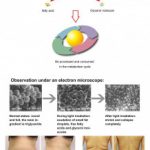light therapy.
Red light therapy and infrared light therapy are two types of light therapy that are becoming increasingly popular for their potential health benefits. While both therapies use light to stimulate healing and reduce inflammation, there are some key differences between them. In this discussion, we will explore the differences between red light therapy and infrared light therapy and try to determine which one may be better for various health conditions.
Contents
An Overview of Light Therapy
Light therapy is a form of treatment that uses different wavelengths of light to improve various health conditions. The two most popular types of light therapy are red light therapy and infrared therapy. Both red light and infrared therapy are non-invasive, meaning that they do not require surgery or medication to be effective.
The Science Behind Light Therapy
Red light therapy and infrared therapy work by penetrating the skin and stimulating the body’s natural healing processes. The light waves help to increase circulation and reduce inflammation, which can lead to faster healing times and reduced pain. Additionally, these therapies can also increase the production of collagen, which is important for maintaining healthy skin and joints.
Benefits of Light Therapy
Light therapy has been shown to be effective for a variety of health conditions. Some of the most common benefits of light therapy include:
- Reduced pain and inflammation
- Improved circulation
- Faster healing times
- Improved skin health
- Increased production of collagen
Understanding Red Light Therapy
Red light therapy uses wavelengths of light between 620 and 700 nanometers to penetrate the skin and stimulate the body’s natural healing processes. This type of therapy is often used to treat skin conditions such as acne, rosacea, and eczema. Additionally, red light therapy is also popular for reducing pain and inflammation in muscles and joints.
How Red Light Therapy Works
Red light therapy works by penetrating the skin and stimulating the production of collagen. Collagen is an essential protein that is responsible for maintaining healthy skin and joints. By increasing the production of collagen, red light therapy can help to reduce the appearance of wrinkles, improve skin texture, and reduce joint pain.
Benefits of Red Light Therapy
Red light therapy has been shown to be effective for a variety of health conditions. Some of the most common benefits of red light therapy include:
- Improved skin texture and appearance
- Reduced acne and rosacea
- Reduced joint pain and inflammation
Understanding Infrared Therapy
Infrared therapy uses wavelengths of light between 700 and 1,000 nanometers to penetrate the skin and stimulate the body’s natural healing processes. This type of therapy is often used to treat muscle and joint pain, as well as to improve circulation and reduce inflammation.
One key takeaway from this text is that both red light therapy and infrared therapy are non-invasive treatments that use different wavelengths of light to improve various health conditions. They both work by penetrating the skin and stimulating the body’s natural healing processes, and have been shown to be effective for reducing pain and inflammation, improving circulation and skin health, and increasing the production of collagen. The choice between these therapies depends on the specific health condition being treated, as red light therapy is better for skin conditions while infrared therapy is better for muscle and joint pain. Ultimately, the decision should be based on personal preference and individual needs.
How Infrared Therapy Works
Infrared therapy works by penetrating the skin and stimulating the body’s natural healing processes. The light waves help to increase circulation and reduce inflammation, which can lead to faster healing times and reduced pain. Additionally, infrared therapy can also increase the production of collagen, which is important for maintaining healthy skin and joints.
Benefits of Infrared Therapy
Infrared therapy has been shown to be effective for a variety of health conditions. Some of the most common benefits of infrared therapy include:
- Reduced muscle and joint pain
- Increased circulation
- Reduced inflammation
Comparing Red Light Therapy and Infrared Therapy
When it comes to choosing between red light therapy and infrared therapy, there are a few key differences to consider. The main difference between the two is the wavelength of light used. Red light therapy uses wavelengths of light between 620 and 700 nanometers, while infrared therapy uses wavelengths of light between 700 and 1,000 nanometers.
Which is Better?
The answer to this question depends on the specific health condition being treated. In general, red light therapy is better for treating skin conditions such as acne and rosacea, while infrared therapy is better for treating muscle and joint pain. However, both types of therapy have been shown to be effective for a variety of health conditions, so it ultimately comes down to personal preference and the specific needs of the individual.
FAQs – Which is better: Red light therapy or Infrared?
What is red light therapy?
Red light therapy involves the use of red light wavelengths to treat a variety of health conditions including skin concerns, joint pain, and more. It is a non-invasive treatment that involves exposing the skin to red light wavelengths, typically around 660 nanometers. This can be done using a range of devices, such as light panels, lamps, or handheld devices.
What is Infrared?
Infrared is a type of light that is invisible to the eye, but can be detected by the skin as heat. Infrared wavelengths are longer than those of visible light, with a range between 700 nanometers and 1 millimeter. Infrared light can penetrate the skin, providing warmth and relaxation. Infrared therapy is used to treat a wide range of conditions, including pain and inflammation.
What are the benefits of red light therapy?
Red light therapy has many potential benefits, including helping to reduce the signs of aging, such as wrinkles and fine lines. It can also improve skin clarity and reduce acne, as well as alleviate pain and inflammation in the joints. Red light therapy may also improve sleep quality, increase circulation, and boost energy levels.
What are the benefits of infrared therapy?
Infrared therapy has many potential benefits, including helping to reduce pain and inflammation in the joints, improving circulation, and reducing muscle stiffness. It can also promote relaxation and boost the immune system. Infrared therapy is a popular treatment option for those with chronic pain conditions or who experience muscle soreness after exercise.
Which is better: Red light therapy or Infrared?
both red light therapy and infrared therapy offer a range of potential benefits, and which is better largely depends on the specific condition being treated. Red light therapy is typically used for skin concerns and joint pain, while infrared therapy is often used to treat muscle pain and inflammation. It is important to consult with a healthcare professional to determine which type of therapy is best for you.







